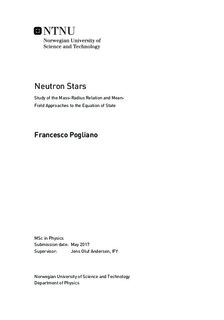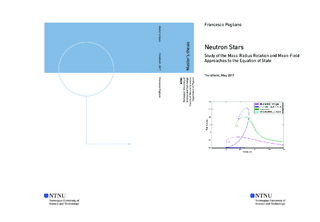| dc.description.abstract | The structure and the relation between the total mass, the radius and the central energy density of a neutron star may be found by numerically solving a set of three coupled differential equations. One of these equations is the equation of state, relating the pressure to the energy density. In this thesis, after introducing some important concepts of general relativity, quantum mechanics, quantum field theory and thermal field theory, we will discuss the equation of state using different models. The first is the sigma-omega model, later expanded to include leptons and the rho meson in what in the literature is referred to as npe-mu matter. In the last part we also consider the shift in the vacuum energy due to the presence of matter. Some focus has been given to the first-order phase transition in neutron matter as conceived in the paper from Chin et al. (1974). Although unphysical, the theory behind the phase transition is a first step for understanding more complex phase transitions between hadronic and quark matter in hybrid stars. | |

